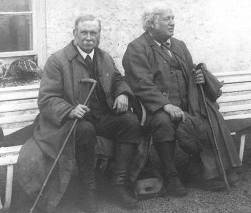
January 2007 Vol. 17,1
Rob Butler* dusts down his copy of the North-West Highlands Memoir to find that it still talks to 21st Century geoscientists a century later…
On a small hill overlooking Loch Assynt in NW Scotland is a famous yet simple stone memorial to a remarkable geological double act: Ben Peach and John Horne. Generations of students have driven past this site, on their way to another, often rain-cooled day of field training, perhaps regaled by their lecturers of the exploits of their forebears and the golden years of NW Highland geology, at the end of the 19th Century.
Much has been written over the years of these times and the exploits of the various protagonists. Visitors to the nearby Inchnadamph Hotel will have seen the famous photograph of the pair and perhaps posed on the bench outside the bar. This Bicentenary year also marks the centenary of Peach and Horne’s most remarkable publication, the Memoir The Geological Structure of the North-West Highlands of Scotland. Not only was it an instant classic, the 1907 Memoir remains a masterpiece of regional geoscience.
Famously Edward Suess, the Alpine tectonicist and synthesizer, remarked that Peach and Horne’s work had rendered the mountains transparent. The Memoir made key statements about structural geology, opening debates that remain unresolved and establishing NW Scotland as a key site in world geology. This importance continues today, with the recent designation of the region as a UNESCO Geo-Park. So what’s in the 1907 NW Highlands Memoir?
The geology of NW Scotland is highly varied, so the Memoir covers a lot of ground. The basic sedimentary units and their relationships are of course fully described. Perhaps I betray my background but it’s for the structural geology that I find the Memoir most perceptive. There are substantial discussions on the geology and evolution of the Lewisian complex, much of which we take for granted today. Peach, Horne and colleagues mapped out basic field relationships and used these to deduce a long and complex tectono-metamorphic history. The terms Scourian and Laxfordian were not coined until the 1950s by John Sutton and Janet Watson. But the Survey geologists had established that the meta-basic sheets within the Lewisian represented dykes and sills at different states of deformation and established the workflows for building tectono-metamorphic histories in basement rocks. What Sutton & Watson did was to make more detailed maps, but they followed essentially the same workflows.
Using the Survey maps for context, Peach and Horne’s colleague Jethro Justinian Harris Teall made detailed petrological studies to deduce links between deformation and metamorphism. This fired the starting pistol for research on reaction-related softening mechanisms in the continental lithosphere that continues today. By recognising that “the old lines of movement which existed before the Torridon Sandstone was laid down have in some places been used again in post-Torridonian time” (p. 251), the team were fully aware of the notions of structural inheritance, an issue again that is alive today.